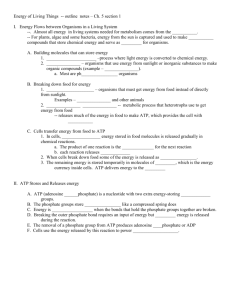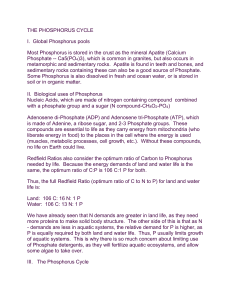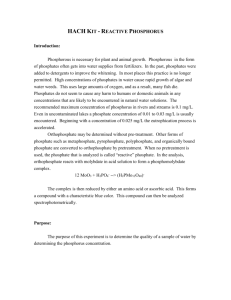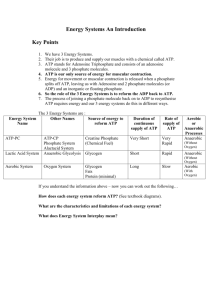Functions of Phosphorus in Plants
advertisement
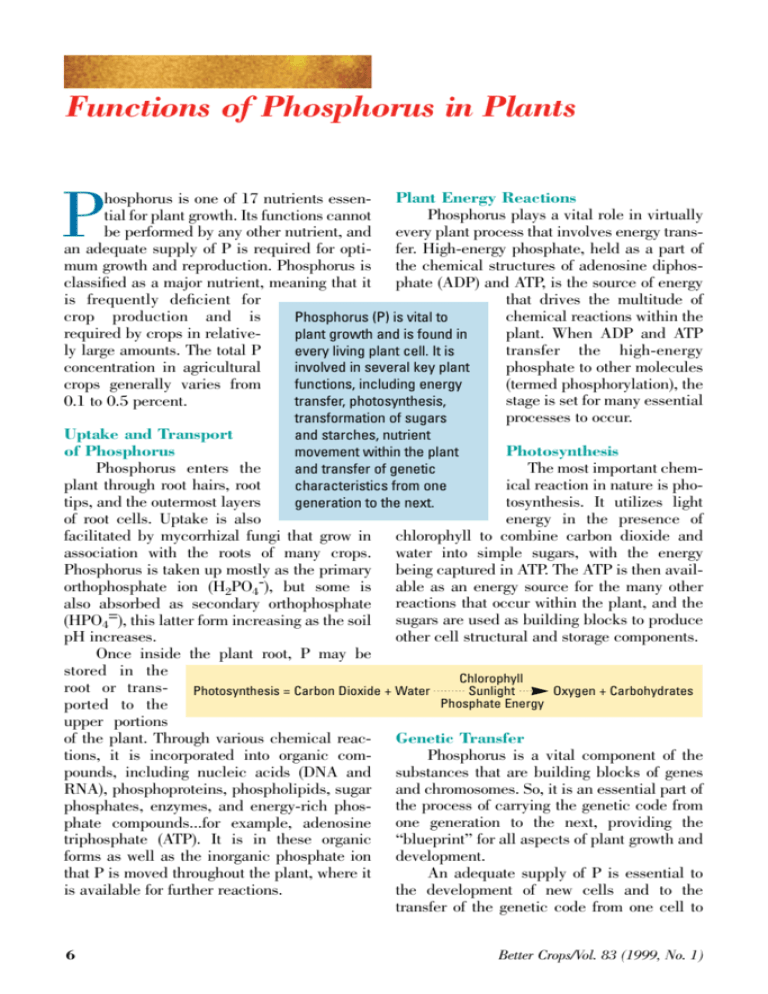
Functions of Phosphorus in Plants P hosphorus is one of 17 nutrients essen- Plant Energy Reactions Phosphorus plays a vital role in virtually tial for plant growth. Its functions cannot be performed by any other nutrient, and every plant process that involves energy transan adequate supply of P is required for opti- fer. High-energy phosphate, held as a part of mum growth and reproduction. Phosphorus is the chemical structures of adenosine diphosclassified as a major nutrient, meaning that it phate (ADP) and ATP, is the source of energy that drives the multitude of is frequently deficient for chemical reactions within the crop production and is Phosphorus (P) is vital to plant. When ADP and ATP required by crops in relativeplant growth and is found in transfer the high-energy ly large amounts. The total P every living plant cell. It is phosphate to other molecules concentration in agricultural involved in several key plant (termed phosphorylation), the crops generally varies from functions, including energy stage is set for many essential 0.1 to 0.5 percent. transfer, photosynthesis, processes to occur. transformation of sugars Uptake and Transport and starches, nutrient Photosynthesis of Phosphorus movement within the plant The most important chemPhosphorus enters the and transfer of genetic ical reaction in nature is phoplant through root hairs, root characteristics from one tosynthesis. It utilizes light tips, and the outermost layers generation to the next. energy in the presence of of root cells. Uptake is also facilitated by mycorrhizal fungi that grow in chlorophyll to combine carbon dioxide and association with the roots of many crops. water into simple sugars, with the energy Phosphorus is taken up mostly as the primary being captured in ATP. The ATP is then availorthophosphate ion (H2PO4-), but some is able as an energy source for the many other also absorbed as secondary orthophosphate reactions that occur within the plant, and the (HPO4=), this latter form increasing as the soil sugars are used as building blocks to produce other cell structural and storage components. pH increases. Once inside the plant root, P may be stored in the Chlorophyll root or trans- Photosynthesis = Carbon Dioxide + Water Sunlight Oxygen + Carbohydrates Phosphate Energy ported to the upper portions of the plant. Through various chemical reac- Genetic Transfer Phosphorus is a vital component of the tions, it is incorporated into organic compounds, including nucleic acids (DNA and substances that are building blocks of genes RNA), phosphoproteins, phospholipids, sugar and chromosomes. So, it is an essential part of phosphates, enzymes, and energy-rich phos- the process of carrying the genetic code from phate compounds...for example, adenosine one generation to the next, providing the triphosphate (ATP). It is in these organic “blueprint” for all aspects of plant growth and forms as well as the inorganic phosphate ion development. An adequate supply of P is essential to that P is moved throughout the plant, where it the development of new cells and to the is available for further reactions. transfer of the genetic code from one cell to 6 Better Crops/Vol. 83 (1999, No. 1) another as new cells are formed. Large quantities of P are found in seeds and fruit where it is believed essential for seed formation and development. Phosphorus is also a component of phytin, a major storage form of P in seeds. About 50 percent of the total P in legume seeds and 60 to 70 percent in cereal grains is stored as phytin or closely related compounds. An inadequate supply of P can reduce seed size, seed number, and viability. Nutrient Transport Plant cells can accumulate nutrients at much higher concentrations than are present in the soil solution that surrounds them. This allows roots to extract nutrients from the soil solution where they are present in very low concentrations. Movement of nutrients within the plant depends largely upon transport through cell membranes, which requires energy to oppose the forces of osmosis. Here again, ATP and other high energy P compounds provide the needed energy. Phosphorus Deficiency Adequate P allows the processes described above to operate at optimum rates and growth and development of the plant to proceed at a normal pace. When P is limiting, the most striking effects are a reduction in leaf expansion and leaf surface area, as well as the number of leaves. Shoot growth is more affected than root growth, which leads to a decrease in the shootroot dry weight ratio. Nonetheless, root growth is also reduced by P deficiency, leading to less root mass to reach water and nutrients. Generally, inadequate P slows the processes of carbohydrate utilization, while carbohydrate production through photosynthesis continues. This results in a buildup of carbohydrates and the development of a dark green leaf color. In some plants, P-deficient leaves develop a purple color, tomatoes and corn being two examples. Since P is readily mobilized in the plant, when a deficiency occurs the P is translocated from older tissues to active meristematic tissues, resulting in foliar deficiency symptoms appearing on the older (lower) portion of the plant. However, such symptoms of P deficiency are seldom observed in the field...other than loss of yield. Other effects of P deficiency on plant growth include delayed maturity, reduced quality of forage, fruit, vegetable, and grain crops, and decreased disease resistance. World Production... (continued from page 5) U.S. consumption, '000 tons Canadian consumption, '000 tons 1975 to 1979 (Figure 1). Consumption reached a high of 798,164 tons of P2O5 in declined to an average of 4.3 million tons 1985 (Figure 1). Consumption declined to yearly during the 1985-1989 period, but 637,175 tons in 1991, but has since has since begun increasing, averaging increased to 775,370 tons in 1997. About about 4.5 million tons since 1995. 75 percent of Canada’s phosphate conIllinois led the U.S. in phosphate con- sumption occurs in the prairie provinces sumption in 1997, followed by Iowa, (Alberta, Manitoba and Saskatchewan). Minnesota and Texas (Table 3). Others in the top 10 consuming states 1,000 6,000 included Nebraska, California, 5,000 800 Indiana, Kansas, Missouri, and 4,000 600 North Dakota. These 10 states 3,000 400 accounted for 55 percent of 2,000 Canada 200 U.S. 1,000 U.S. phosphate consumption. 0 0 Canadian consumption of 1960 1964 1968 1972 1976 1980 1984 1988 1992 1996 fertilizer phosphate followed Year similar trends to the U.S., but Figure 1. Consumption of P2O5 in North America. Better Crops/Vol. 83 (1999, No. 1) 7


